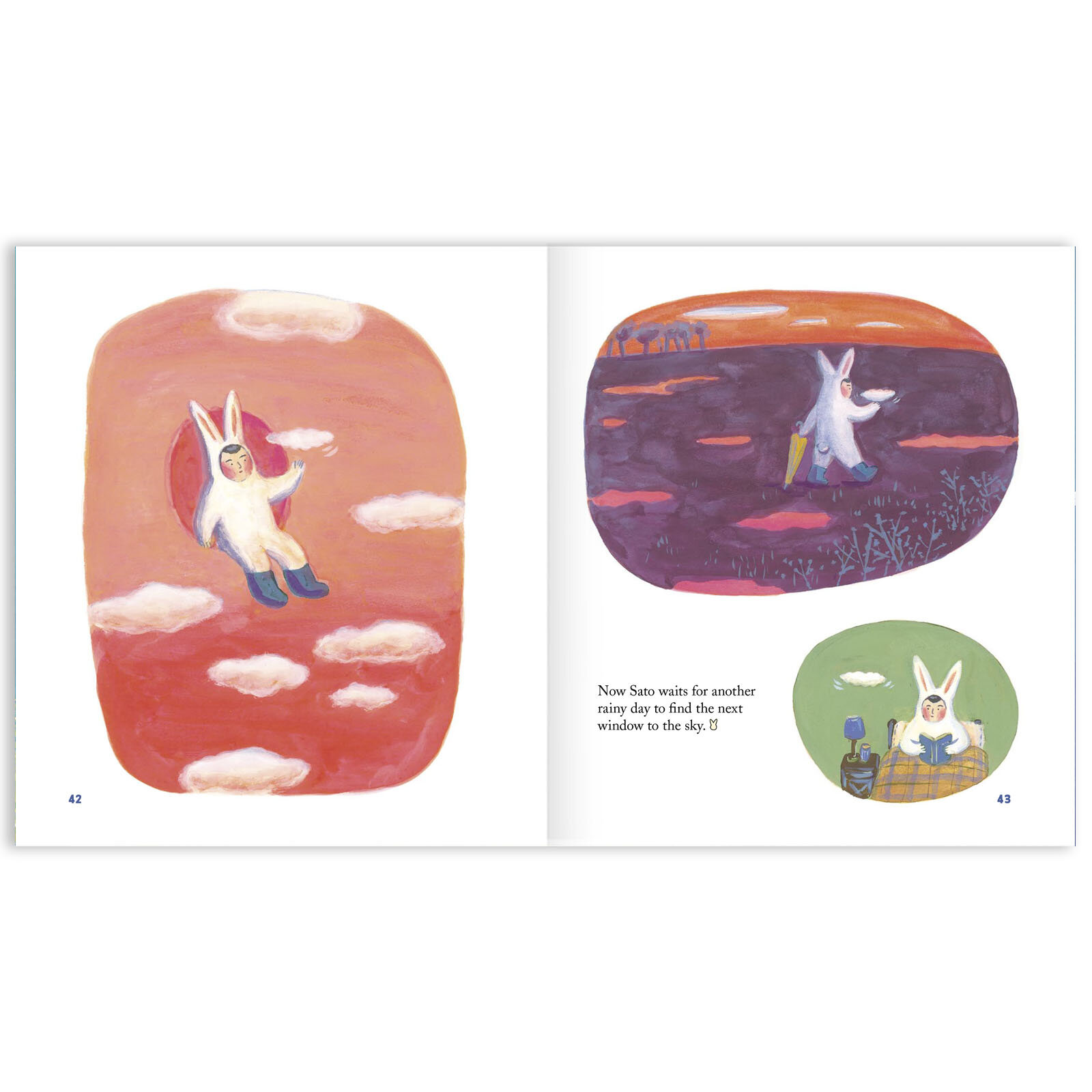Sato the Rabbit






Sato the Rabbit
*This title will also be available on Bookshop, an organization that supports independent bookstores!
Written and illustrated by Yuki Ainoya
Translated by Michael Blaskowsky
A Horn Book Fanfare selection for 2021
A Chicago Public Library Best of the Best Book of 2021
A 100 Scope Notes Most Astonishingly Unconventional Book of 2021
A 2022 Mildred L. Batchelder Honor Book
A Bank Street College of Education Best Book of 2022
Featured in New York Magazine's 2024 Holiday Gift Guide: Best Books to Gift to Little Kids
Adventure along with Sato the Rabbit as puddles on the ground become doors into the sky and stars fall into his fishing net to light the darkest night.
Do you ever wonder what wonderful things might be hiding in the world that we can’t immediately see? What stories your breakfast would tell you if it could talk, or where your pet would take you in its dreams? Haneru Sato thinks such things, so one day, he decides to find out how the world will change if he changes a little, too. He becomes a rabbit and discovers a world where every corner is a door to somewhere new and the simplest actions lead in unexpected directions. Coming from Japan, this whimsical book is the first in a trilogy.
ISBN: 978-1-59270-318-0
7” (W) x 8” (H) • 68 pages • HCJ
TRANSLATOR INTERVIEW: A Conversation with Michael & Shizuka Blaskowsky
Michael and Shizuka Blaskowsky discuss the differences between American and Japanese storybooks, the immersive power of illustrations, and the endless possibilities of Sato’s dreamlike and fantastical world. Read part one and part two on our blog!
AWARDS AND REVIEWS
A Chicago Public Library Best of the Best Book of 2021
A Horn Book Fanfare selection for 2021
A 100 Scope Notes Most Astonishingly Unconventional Book of 2021
A 2022 Mildred L. Batchelder Honor Book
A Bank Street College of Education Best Book of 2022
Featured in Elle Magazine: "Bryan Washington’s 2025 Book Recommendations”
Featured in New York Magazine's 2024 Holiday Gift Guide: Best Books to Gift to Little Kids
One of the “12 Picture Book Recommendations for the Young Ones in Your Life” from Orion Magazine
"The Sato books encourage parents to meet their children where they are—in a space of focussed exploration—rather than relentlessly pulling kids toward adulthood through narratives that educate or pontificate. In fact, reading them in the bright quiet of morning, with an attentive child, feels like childhood itself." —Nausicaa Renner, for The New Yorker
“Enchanted Lion is a publisher who appreciates the unconventional side of children’s literature, and Japanese import Sato the Rabbit is a perfect example of this. Just your average, everyday story about a boy who has decided to be a rabbit and his whimsically surreal life and adventures.” —Travis Jonker, 100 Scope Notes (A School Library Journal blog)
★ "Sato...walks upright through a natural world reminiscent of the Chirri & Chirra series—one that offers enchanting and sometimes droll revelations. He waters his garden, and a spread traces the water along a twisting, turning course through the forest back to its source, a pond that, in Blaskowsky’s natural-sounding translation, “is blowing water into the hose as hard as it can.” Each episode is over in a few pages, and every one offers kaleidoscopic, pleasingly sensorial images made for dreaming on." —STARRED REVIEW, Publishers Weekly
★ "In a set of seven small vignettes that span the seasons, Sato’s daily activities — watering the garden, doing the laundry, splashing in puddles — turn into magic. Cracking open a walnut reveals an inviting miniature world. Eating a watermelon turns into a seafaring adventure. (“Nothing compares to eating watermelon on the sea.”) Observing a meteor shower leads to a star-collection mission. Paintings in a naive style burst with saturated color — watermelon red, night-sky blue, spring chartreuse. For fans of Doi’s Chirri & Chirra books, this import provides another cozy glimpse into mystery, independence, and imaginative play. " —STARRED REVIEW, The Horn Book
“Our hero in this compact little picture book (translated by Michael Blaskowsky) is a boy who wears a rabbit costume and sees all sorts of wonderful possibilities in the world. While watering the garden, he imagines—as we see in a beguiling painting—that a distant pond is “blowing water into the hose as hard as it can.” Noticing the sunset reflected in a puddle, Sato the Rabbit lifts up its rosy surface, like a luminous manhole cover, and finds himself transported to the sky. In another story, Sato cracks walnuts and discovers tiny loaves of bread and a pot of hot coffee inside one set of shells, a miniature bed and steaming bath inside another. The soft lines and delectable colors of Ms. Ainoya’s pictures, and their charming details (the walnut bath has a loofah and a little towel rack), will have 4- to 8-year-olds wishing they could climb into Sato’s world. Their parents may wish it, too.” —The Wall Street Journal
"This remarkably child-friendly story is a treat. Sato’s world is one of metamorphoses both extraordinary and surreal. Translated from Japanese by Michael Blaskowsky, the text captures the wonder with which children see and experience the world, their senses on overdrive. (When Sato eats a watermelon, we read: “It spreads from his mouth throughout his entire body.”) Ainoya’s soft, expressive illustrations feature warm colors and full-bleed spreads juxtaposed with ones that showcase smaller vignettes of Sato on the move, experiencing — and accepting, without even blinking — the astonishments his imagination has to offer and the ways in which that imagination informs his world." —Julie Danielson, Seven Impossible Things Before Breakfast
"A child’s vivid imagination transforms everyday activities into magical interactions. Similarly charming artwork illustrates the interconnectedness among nature, children, and creativity in six other episodic expeditions featuring distinct themes...alongside Sato, readers travel through the seasons while sharing his myriad, surprising lenses on the universe. The journey culminates in a homecoming when Sato settles into bed, cozily “sipping stories late into the night.” The painterly illustrations suggest homage to Where the Wild Things Are, works by Eric Carle, and others. Sweet, surreal, and contemplative." —Kirkus Reviews
“In seven short imaginative tales, Sato’s imagination transforms the details of ordinary life into fanciful antics that embrace and enhance the natural world.” —American Library Association
“Gentle lighthearted humor throughout the text delights the reader and endears them to the imaginative and ingenious Sato.” —Dr. Marie A. Lejeune, 2022 Batchelder Chair
“Dreamlike and fanciful, each adventure is as much a flight of fancy as it is a plunge into gorgeous colors and shapes. Sato catches stars during a meteor shower, and the yellow glow guides a family of bears on a moonless night; he eats delicious watermelon which becomes a boat in the sea; while cracking open walnuts, he discovers miniature treasures inside each shell - loaves of bread, a warm bath - and when he covers his eyes with the shells, he finds himself beneath a sky full of stars. The ocean, clouds, the night sky, reflections - these are the cosmic places Sato explores in each beautifully wrought adventure. Simple, brief poetic text and illustrations in rounded shapes, in light and dark toned pastel colors, add to the feeling of wonder.” —Youth Services Book Review
“Each story starts with Sato doing a more or less normal activity. He does laundry. He eats watermelon. He cracks open walnuts. He goes for a walk to an observatory. And then each story takes a turn and Sato has a fantastical, almost-poetic, experience. He catches stars, he rides a watermelon, he opens a puddle to find a window to the sky. The illustrations with their saturated colors and fun details enhance the poetic feel. Sato swims in the bright teal sea next to his hot pink watermelon boat. He wears a bathing suit that matches the green striped rind; a whale spouts in the distance. This is a world that I would love to step into where the forest ice is full of feelings and colors and stories. A beautiful world for young readers." —Jackie Friedman Mighdoll, World Kid Lit
"A surreal symphony of vibrant colors and images, Sato the Rabbit is a whimsical trilogy of picture books for readers age 4-8... All three books in Sato the Rabbit are a satisfying ode to the deep power—and beauty—of the imagination." —Nanette McGuiness, World Kid Lit
"Another character that’s captured my kids’ imaginations for years is Yuki Ainoya’s Sato the Rabbit. Each book in the series depicts a child dressed as a rabbit in magical vignettes that bridge reality and the imagination... Capturing both the poetic, gentle, and spiritual ways a child may experience nature, Sato is a portrayal of a magical reality." —Youngna Park, for New York Magazine, The Strategist
One of the “12 Picture Book Recommendations for the Young Ones in Your Life” from Orion Magazine! “[A] fanciful, dreamlike series where wonders never cease. In Sato’s world, one might catch falling stars in a long-handled net, or open a walnut to find a pot of steaming coffee inside. Here, watermelon rinds make good boats, and puddles can be opened like portals. And if blue ice gives your tea a sad flavor, try melting some orange ice to bring good cheer.” —Orion Magazine
